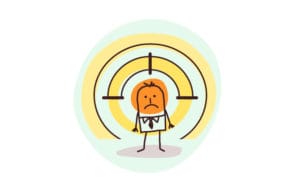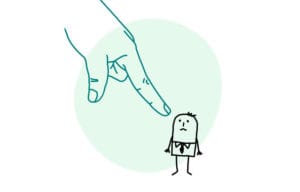
Shyness can become sickly when it becomes too intrusive. This is called social phobia because it prevents the person from realizing his or her full potential. What is the difference between these two notions? The shyness qualified as social phobia by psychologists will have several characteristics. Symptoms often include flushing, sweating, tachycardia, chest discomfort or tightness, difficulty breathing, hyperventilation, nausea, stuttering, increased verbal flow, tremors, etc.
Cognitively, persons with social phobia often have the idea of being perceived as stupid or weird. They place too much emphasis on how they are perceived by others. As a result, they focus on themselves and trigger a vicious circle. This leads to fear and anxiety, i.e. the person watches for the appearance of certain information such as the signs they fear will appear (their physical, physiological signs and thoughts). And of course the person triggers the signs by looking for them… This is called cognitive distortion.
Many social interactions are negatively affected by social phobia. For some, only performance situations such as public speaking will trigger phobic symptoms. For others, more basic situations such as talking to a stranger is enough to trigger the symptoms.
The DSM 4 defines social phobia or sickly shyness as follows:
- Persistent and intense fear of one or more social or performance situations in which the subject is in contact with unfamiliar people or may be exposed to close observation by others. Fear of acting (showing anxiety symptoms) in an embarrassing or humiliating manner.
- Exposure to the dreaded social situation almost always causes anxiety, which can take the form of a panic attack linked to the situation or facilitated by the situation.
- The subject recognizes the excessive or irrational nature of the fear.
- Social or performance situations are avoided or experienced with intense anxiety and distress.
- Avoidance, anxious anticipation or suffering in the social or performance situation(s) significantly disrupts the individual’s habits, work (school) activities, or social activities or relationships with others, or having this phobia is accompanied by a significant feeling of suffering.
- For individuals under the age of 18, the duration is at least 6 months.
- Fear or avoidance behavior is not related to the direct physiological effects of a substance (e.g., a substance of abuse, medication) or a general medical condition and is not better explained by another mental disorder (e.g., panic disorder with or without agoraphobia, separation anxiety disorder, body dysmorphic disorder, pervasive developmental disorder or schizoid personality).
- If a general condition or other mental disorder is present, the fear described in point 1. is independent of these disorders: for example, the subject is not afraid due to stuttering, to shake in the case of Parkinson’s disease, or to reveal abnormal eating behavior in anorexia nervosa or bulimia nervosa.
Social phobia or sickly shyness is not the only risk
Social phobia is often associated with depression, anxiety disorders and addiction. This is quite logical since the person affected will find himself isolated more often than he would like, making the bed of depression. As for substance dependency, substances are frequently used to calm the anxiety and tension created by the phobia. It is a kind of self-medication with the products that the person has in reach .

The origins of social phobia
The causes of social phobia, like many disorders and diseases, are multifactorial, i.e. they have different origins. The cause is not due to a single thing, a single factor, but many. The disease appears when a number of factors come together in a person’s life. These factors are often of biological, psychological and environmental origin.
Biological causes range from simple products such as coffee or alcohol to hormones or neuromediators that are naturally present in the body. Some studies have compared the risk of social phobia in homozygous twins raised in different families. If one twin triggers a social phobia, the second twin has a 30-50% increased risk of developing a social phobia as well. Having a parent with social phobia also increases the risk 2-3 times. But it is possible that this is caused by the child’s observations and therefore learning about difficult social relationships from social phobic parents. This last example would illustrate the environmental and psychological aspects related to the risk of contracting the disorder.
Then, of course, the psychological factors capable of influencing the disorder are, for example, stress when it is badly managed by the person. Factors linked to personality are frequently incriminated here, such as the fact of having a withdrawn, unsociable personality…
How frequent does social phobia happen?
Women are more affected than men and the most common age of onset is between 25 and 45 years of age. One-year prevalence among 18-65 year olds is 15% and lifetime prevalence is 21% in the same age group.
The treatments
CBT works well on a case-by-case basis. Some will simply see their symptoms alleviate and others will see them disappear completely. Thoughts, emotions and behaviors will be the focus of psychotherapy, including exposure exercises. In fact, people with the disorder avoid phobogenic situations and this is what maintains the disorder. It is by eliminating this mechanism very gradually that the person will regain more and more autonomy and well-being. Other approaches such as relaxation, meditation and hypnosis can be used to complement CBT. The psychologist may also ask a physician to temporarily prescribe certain medications to complement psychotherapy.
How can I help you?
We will work on concrete situations and choose one to start with. We will work on as many situations as you wish.
I will teach you to gradually overcome your fear, your overly shyness, your social phobia. We will work on your fears before and during the situation. The goal of the therapy will be that you regain control of these situations through action.
Bibliographie



